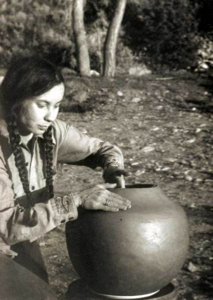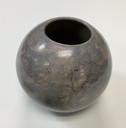Mary Witkop
Indigenous American: Tiwa
Indigenous American: Tiwa, (1948–2010)
Mary Witkop (aka Mary Beatrice Blake Witkop) was influenced early on by her mother who experimented with making pottery and her father who was a jeweler. Mary’s mother also collected pottery from the pueblos of New Mexico including pieces by well-known pueblo potter Maria Martinez exposing her early on to traditional pottery. In 1969 while attending college at Colorado State University, she met self-taught potter, Carl Witkop and took a class in Pre-Columbian art, after which she began experimenting with making her own pots using the ancient methods of coil building, stone burnishing, and pit firing. She was influenced early on by her soon to be husband Carl Witkop, who had been experimenting with Pre-Columbian techniques for a few years, the Unka pottery of Japan, and modern-day potters such as Maria Martinez. Based on these ancient methods, together they developed a new style of pottery unlike anything else being done at the time.
In 1971 while firing pots on the lawn of her brother’s home in Horsetooth, CO, the Witkops discovered that not only could you get black clouding while open firing using cow and sheep dung, you could also obtain interesting markings from other organic materials like grasses when a pot was accidentally dropped and rolled down the lawn. They began experimenting with other materials like hair, leaves, feathers and sawdust. By 1974 most of their pots were fired using this newly discovered method. They called their new firing technique ‘Cloud Fire’ and Cloud-Fire Pottery was born.
In 1975 Mary gave up her career as a research scientist and aspirations to become a veterinarian and decided to pot full time. In 1981 the Witkop’s separated, each continued making pottery and developing their own new designs and techniques. Mary began experimenting more with local clays collected in the Taos area. She also spent more time working with local people, especially pueblo potters such as Jeri Track, Juanita DuBray, the Track sisters Bernadette, Soge and Dahl, Henrietta Gomez, Cheyenne Jim, and Anthony Durand, teaching her techniques and learning from them how to prepare and work with the local clays. She was adamant about one signing their own work.
In 1987 she met David Hopper, beginning a relationship that lasted 23 years. David was a local contractor specializing in adobe construction and restoration, and also owner of the former Return Galley of Taos (1976-1984). She moved her studio from its location in Pilar to the Old Ranchos Post Office, owned by Hopper's brother.
One of things that Taos provided Mary with was a wealth of other artists with whom to collaborate with. The most successful of these collaborations was with Taos Pueblo Stone Sculptor, John Suazo. She traded pottery for many things she needed like hay for the horses, shipping packages, the mechanics who kept her truck running, and even with the dentist and optometrist. Mary’s last show was at the Harwood Museum’s Gift Shop in Jan 2010 where she showed 20 of her small pots. Mary passed away April 13th, 2010 in her studio, leaving several pieces unfinished.
Indigenous American: Tiwa
Indigenous American: Tiwa, (1948–2010)
Mary Witkop (aka Mary Beatrice Blake Witkop) was influenced early on by her mother who experimented with making pottery and her father who was a jeweler. Mary’s mother also collected pottery from the pueblos of New Mexico including pieces by well-known pueblo potter Maria Martinez exposing her early on to traditional pottery. In 1969 while attending college at Colorado State University, she met self-taught potter, Carl Witkop and took a class in Pre-Columbian art, after which she began experimenting with making her own pots using the ancient methods of coil building, stone burnishing, and pit firing. She was influenced early on by her soon to be husband Carl Witkop, who had been experimenting with Pre-Columbian techniques for a few years, the Unka pottery of Japan, and modern-day potters such as Maria Martinez. Based on these ancient methods, together they developed a new style of pottery unlike anything else being done at the time.
In 1971 while firing pots on the lawn of her brother’s home in Horsetooth, CO, the Witkops discovered that not only could you get black clouding while open firing using cow and sheep dung, you could also obtain interesting markings from other organic materials like grasses when a pot was accidentally dropped and rolled down the lawn. They began experimenting with other materials like hair, leaves, feathers and sawdust. By 1974 most of their pots were fired using this newly discovered method. They called their new firing technique ‘Cloud Fire’ and Cloud-Fire Pottery was born.
In 1975 Mary gave up her career as a research scientist and aspirations to become a veterinarian and decided to pot full time. In 1981 the Witkop’s separated, each continued making pottery and developing their own new designs and techniques. Mary began experimenting more with local clays collected in the Taos area. She also spent more time working with local people, especially pueblo potters such as Jeri Track, Juanita DuBray, the Track sisters Bernadette, Soge and Dahl, Henrietta Gomez, Cheyenne Jim, and Anthony Durand, teaching her techniques and learning from them how to prepare and work with the local clays. She was adamant about one signing their own work.
In 1987 she met David Hopper, beginning a relationship that lasted 23 years. David was a local contractor specializing in adobe construction and restoration, and also owner of the former Return Galley of Taos (1976-1984). She moved her studio from its location in Pilar to the Old Ranchos Post Office, owned by Hopper's brother.
One of things that Taos provided Mary with was a wealth of other artists with whom to collaborate with. The most successful of these collaborations was with Taos Pueblo Stone Sculptor, John Suazo. She traded pottery for many things she needed like hay for the horses, shipping packages, the mechanics who kept her truck running, and even with the dentist and optometrist. Mary’s last show was at the Harwood Museum’s Gift Shop in Jan 2010 where she showed 20 of her small pots. Mary passed away April 13th, 2010 in her studio, leaving several pieces unfinished.
Artist Objects
Birds and Flower Vessel 1992.013
Grey Vessel 1992.073



